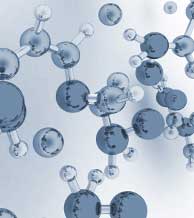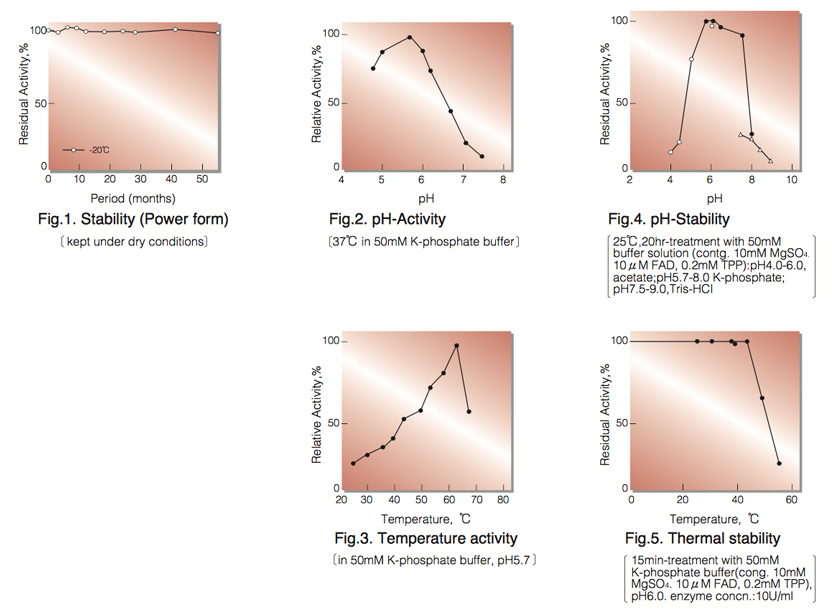PYRUVATE OXIDASE from Microorganism
PYO-311
| Appearance: | Yellowish amorphous powder, lyophilized |
|---|---|
| Activity: | GradeⅢ 1.5U/mg-solid or more |
| Contaminants: | ATPase ≤5.0×10⁻²% GOT, GPT ≤5.0×10⁻²% |
| Stabilizers: | Sugars, FAD |
| Stability: | Stable at -20°C for at least One year (Fig.1) |
|---|---|
| Molecular weight : | approx. 260,000 |
| Isoelectric point : | 4.3 |
| Michaelis constant: | 3.4×10⁻⁴M (Pyruvate) |
| Inhibitors: | Fe⁺⁺,Zn⁺⁺,Cu⁺⁺,Ag⁺,Hg⁺⁺ |
| Optimum pH : | 5.7(Fig.2) |
| Optimum temperature : | 65°C(Fig.3) |
| pH Stability : | pH 5.7-6.5 (25°C, 20hr)(Fig.4) |
| Thermal stability : | below 45°C (pH 6.0, 15min)(Fig.5) |
| Substrate specificity: | (Table 1) |
| Effect of various chemicals : | (Table 2) |
APPLICATIONS
This enzyme is useful for enzymatic determination of pyruvate, GOT, GPT in clinical analysis.
ASSAY
Principle:
pyruvate oxidase
Pyruvate+Pi+O₂+H₂O ► Acetylphosphate+CO₂+H₂O₂
TPP, FAD, Mg++
peroxidase
2H₂O₂+4-Aminoantipyrine+EHSPT ► Quinoneimine dye+4H₂O
The appearance of quinoneimine dye is measured at 550nm by spectrophotometry.
Unit definition:
One unit causes the formation of one micromole of hydrogen peroxide (half a micromole of quinoneimine dye) per
minute under the conditions described below.
Method:
| A. Pyruvate solution: | 0.3M[378mg of Pyruvate・K salt (MW=126.15)/10ml of H₂O] |
|---|---|
| B. K-phosphate buffer, pH 5.9: | 0.15M |
| C. 4-Aminoantipyrine solution : | 0.15% (150mg of 4-Aminoantipyrine/100ml of H₂O) |
| D. EHSPT (TOOS) solution : |
0.3%[300mg of EHSPT (N-Ethyl-N-(2-hydroxy-3-sulfopropyl)-m-toluidine) /100ml of H₂O] |
| E . TPP solution : | 3mM[13.8mg of TPP (Thiamine pyrophosphate)(MW=460.77)/10ml of H₂O] |
| F . FAD solution : | 0.15mM [1.3mg of FAD・2Na salt (MW=865.55)/10ml of H₂O] |
| G. EDTA solution : | 15mM [590mg of EDTA・2Na salt (MW=394.22)/100ml of H₂O] |
| H. MgSO₄ solution : | 0.15M [3.4g of MgSO₄・7H₂O(246.48)/100ml of H₂O] |
| I . Peroxidase solution : | 50U/ml [45mg of peroxidase (110purpurogallin units/mg)/100ml of H₂O] |
| J . Enzyme diluent : | 50mM K-phosphate buffer, pH 5.7 |
Procedure
| Concentration in assay mixture | |
|---|---|
| Pyruvate | 48 mM |
| K-phosphate buffer | 50 mM |
| 4-Aminoantipyrine | 0.48mM |
| EHSPT | 0.58mM |
| TPP | 0.19mM |
| FAD | 0.01mM |
| EDTA | 0.97mM |
| MgSO₄ | 9.7 mM |
| Peroxidase | ca.4.8 U/ml |
1. Prepare the following working solution in a brownish bottle and store on ice.
10ml K-phosphate buffer, pH 5.9 (B)
2ml 4-Aminoantipyrine solution (C)
2ml EHSPT solution (D)
2ml TPP solutionn (E)
2ml FAD solution (F)
2ml EDTA solution (G)
2ml MgSO₄ solution (H)
3ml Peroxidase (I)
2. Pipette 2.5ml of working solution into a cuvette (d=1.0cm), add 0.5ml of pyruvate solution (A), and equilibrate at 37°C for about 5minutes.
3. Add 0.1ml of the enzyme solution* and mix by gentle inversion.
4. Record the increase in optical density at 550nm against water for 3 to 4 minutes in a spectrophotometer thermostated at 37°C, and calculate the ΔOD per minute from the initial linear portion of the curve (ΔOD test). At the same time, measure the blank rate (ΔOD blank) by using the same method as the test except that the enzyme diluent is added instead of the enzyme solution.
* Dissolve the enzyme preparation in ice-cold enzyme diluent (J), dilute to 0.1−0.5U/ml with the same buffer and store on ice.
Calculation
Activity can be calculated by using the following formula :

ΔOD/min (ΔOD test-ΔOD blank)×Vt×df
Volume activity (U/ml) = = ΔOD/min×1.68×df
36.88×1/2×1.0×Vs
Weight activity (U/mg)=(U/ml)×1/C
- Vt
- : Total volume (3.10ml)
- Vs
- : Sample volume (0.10ml)
- 36.88
- : Millimolar extinction coefficient of quinoneimine dye under the assay condition (㎠/micromole)
- 1/2
- : Factor based on the fact that one mole of H₂O₂ produces half a mole of quinoneimine dye.
- 1.0
- : Light path length (cm)
- df
- : Dilution factor
- C
- : Enzyme concentration in dissolution (c mg/ml)
REFERENCES
- L.P.Hager, D.M.Geller and F.Lipman; Fed.Proc.,13, 734 (1954).
- B.Sedewitz, K.H.Schleifer and F.Gotz; J.Bacteriol,160, 273 (1984).
- B.Sedewitz, K.H.Schleifer and F.Gotz; J.Bacteriol,160, 462 (1984).
| Substrate(50mM) | Relative activity(%) | Substrate(50mM) | Relative activity(%) |
|---|---|---|---|
| Pyruvate | 100 | Acetate | 0 |
| α-Ketobutyrate | 5.8 | Acetoacetate | 0 |
| α-Ketoglutarate | 0 | L-Alanine | 0 |
| Oxaloacetate | 0 | L-Aspartate | 0 |
| DL-Lactate | 0 |
| Chemical | Concn.(mM) | Residual activity(%) |
Chemical | Concn.(mM) | Residual activity(%) |
|---|---|---|---|---|---|
| None | − | 100 | NaF | 2.0 | 100 |
| Metal salt | 2.0 | NaN₃ | 20 | 94 | |
| MgCl₂ |
96 | EDTA | 5.0 | 107 | |
| CaCl₂ | 93 | o-Phenanthroline | 2.0 | 97 | |
| Ba(OAc)₂ | 97 |
α,α′-Dipyridyl | 1.0 | 95 | |
| FeCl₃ | 8.4 | Borate | 50 | 102 | |
| CoCl₂ | 84 |
IAA | 2.0 | 102 | |
| MnCl₂ | 76 | NEM | 2.0 | 104 | |
| ZnSO₄ | 48 | Hydroxylamine | 2.0 | 98 | |
| Cd(OAc)₂ | 86 |
Triton X-100 | 0.10% | 143 | |
| NiCl₂ | 119 |
Brij 35 | 0.10% | 133 | |
| CuSO₄ | 0.9 |
Tween 20 | 0.10% | 146 | |
| Pb(OAc)₂ | 33 |
Span 20 | 0.10% | 121 | |
| AgNO₃ | 0 | Na-cholate | 0.10% | 116 | |
| HgCl₂ | 0 | SDS | 0.05% | 85 | |
| PCMB | 1.0 | 66 | DAC | 0.05% | 53 |
| MIA | 2.0 | 96 |
Ac, CH₃CO; PCMB, p-Chloromercuribenzoate; MIA, Monoiodoacetate; EDTA, Ethylenediaminetetraacetate; IAA, Iodoacetamide; NEM, N-Ethylmaleimide; SDS, Sodium dodecyl sulfate; DAC, Dimethylbenzylallkylammonium chloride.

To get a quote, contact us at info@toyobousa.com, or INQUIRY.
